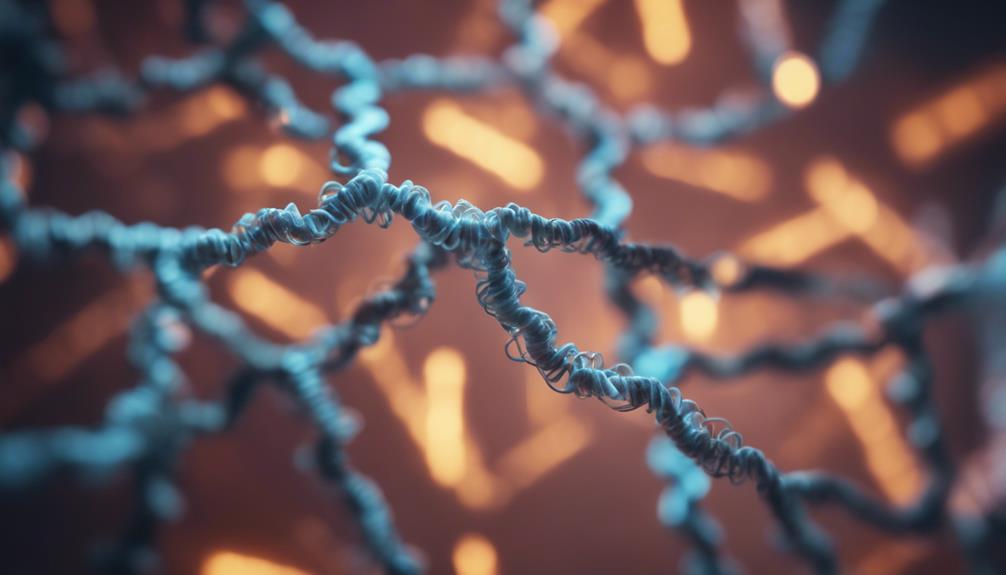Genetic associations and behavioral interplays shed light on the intricate cluster of Narcissistic Personality Disorder. Understanding the role of MAOA genotypes and allelic variations reveals how genetic predispositions interact with environmental factors to shape NPD traits. The elaborate web of family dynamics, adverse experiences, and individual characteristics contributes to the nuanced complexities of this disorder. By delving into genetic influences and behavioral patterns, one can unravel the multifaceted nature of NPD. If you explore further, you'll discover the diverse subtypes, diagnostic approaches, and tailored treatment strategies essential in addressing Narcissistic Personality Disorder thoroughly.
Key Takeaways
- Genetic variations, like low MAOA activity, influence narcissistic traits.
- Environmental factors interact with genetic predispositions in NPD development.
- Family dynamics play a crucial role in exacerbating or mitigating NPD traits.
- NPD comprises various subtypes, such as grandiose and vulnerable.
- Comprehensive understanding needed for effective NPD diagnosis and treatment.
Genetic Associations With Narcissistic Traits
In our exploration of genetic associations with narcissistic traits, research has revealed a link between low MAOA activity and the modulation of aggression and impulsive behavior in individuals exhibiting narcissistic tendencies. Genetic variation, particularly in MAOA activity, plays a pivotal role in understanding how aggression and impulsivity manifest in individuals with narcissistic traits. Studies have shown that MAOA-deficient individuals, due to genetic alterations, may exhibit deviant behaviors that align with narcissistic tendencies. This highlights the intricate interplay between genetic predispositions and behavioral outcomes in individuals displaying narcissistic traits.
Furthermore, environmental interactions, especially early social experiences, can influence allelic variations in MAOA activity and its relationship with narcissistic traits. This underscores the complex nature of narcissistic behaviors, where genetic and environmental factors intertwine to shape personality features. Behavioral genetics approaches, focusing on how gene variants like MAOA impact neurocircuit functionality and quantitative traits related to narcissistic behaviors, provide valuable insights into the underlying mechanisms of narcissistic traits.
MAOA-LPR Genotypes and Narcissism

Examining the correlation between MAOA-LPR genotypes and narcissism sheds light on the genetic underpinnings of Cluster B personality disorders. Research has linked specific MAOA-LPR genotypes to narcissistic traits, indicating a potential genetic basis for certain behaviors associated with narcissism. These genotypes play a role in regulating aggression and impulsive behavior, which are key components of narcissistic traits.
Genetic variations in MAOA activity may modestly contribute to impulsive-aggressive and anxious-depressive traits observed in individuals with narcissistic personality disorder. Understanding how MAOA-LPR genotypes influence these traits can provide insight into the biological mechanisms behind narcissistic behaviors. By delving into the genetic aspects of narcissism, we gain a deeper understanding of the complex interplay between genes and behavior in the manifestation of Cluster B personality disorders.
This knowledge can pave the way for more targeted interventions and treatments tailored to individuals with specific genetic predispositions related to narcissistic traits.
Behavioral Genetics of Narcissistic Personality

Genetic influences play a significant role in shaping the behavioral patterns observed in individuals with Narcissistic Personality Disorder (NPD).
Understanding the heritability of narcissistic traits can provide valuable insights into the development and manifestation of NPD.
Genetic Influences on Narcissism
Exploring the role of genetic influences in shaping narcissistic personality traits reveals intriguing connections between MAOA activity and behavioral tendencies. Genetic variation in MAOA activity is associated with modulating aggression and impulsive behavior in individuals exhibiting narcissistic traits.
Studies indicate that allelic variations of MAOA contribute to impulsive-aggressive and anxious-depressive traits in such individuals. Intriguingly, inactivating MAOA in animal models links to aggressive behavior and neuroadaptive changes, hinting at a genetic influence on narcissistic traits.
It's worth noting that allelic variation of MAOA may not have a significant impact on personality characteristics in certain populations, emphasizing the intricate interplay between genetics and environmental factors in the development of narcissistic traits. This underscores the significance of considering both genetic predispositions and environmental interactions in understanding narcissistic personality traits.
Heritability of Narcissistic Traits
Considering the intricate interplay between genetic predispositions and environmental influences, the heritability of narcissistic traits reveals a complex web of factors shaping personality development.
Heritability studies suggest that genetic factors contribute greatly to the development of narcissistic traits, with allelic variations in specific genes like MAOA potentially influencing the expression of narcissistic behaviors. Genetic predisposition, in conjunction with environmental factors, plays an important role in molding narcissistic personality traits.
Research in behavioral genetics indicates that certain genetic variations can impact the neurodevelopment associated with narcissistic traits. Understanding the interplay between genetic influences and environmental interactions is essential for unraveling the heritability of narcissistic personality features, shedding light on the intricate mechanisms underlying the manifestation of these traits.
Impact of Allelic Variations on Narcissism

Studying allelic variations in genes like MAOA sheds light on how impulsive-aggressive traits connected to narcissistic personality disorder may be influenced. Variations in the MAOA gene can play a role in the development of narcissistic traits, particularly with regards to aggression and impulsivity. Individuals with low MAOA activity due to genetic differences may exhibit heightened levels of aggression, which are often observed in those with narcissistic tendencies. These genetic risk factors can interact with environmental stressors, such as childhood maltreatment, to shape the manifestation of narcissistic personality traits.
| Allelic Variations in MAOA | Influence on Narcissistic Traits |
|---|---|
| Low MAOA activity | Increased aggression and impulsivity |
| Interplay with environmental stressors | Development of narcissistic traits |
Understanding how allelic variations in genes like MAOA interact with environmental factors is essential in comprehending the complex interplay of genetic and environmental influences on narcissistic personality disorder. This intricate relationship highlights the importance of considering both genetic predispositions and external factors in understanding the development of narcissistic traits.
Genetic Predispositions and Environmental Influences

Genetic predispositions and environmental influences both play important roles in the development of Narcissistic Personality Disorder.
Family dynamics and early social experiences can greatly impact how genetic predispositions manifest in individuals.
Understanding the interplay between nature and nurture is vital in thoroughly addressing NPD risk factors.
Nature Vs. Nurture Debate
In understanding the development of Narcissistic Personality Disorder, the interplay between genetic predispositions and environmental influences reveals a complex and multifaceted origin.
Genetic predispositions contribute to the manifestation of NPD traits, while environmental factors like trauma and parenting styles also play a significant role.
Negative developmental experiences in childhood, combined with a fragile ego, can lead to the emergence of NPD behaviors.
Recent studies highlight a genetic influence in personality disorders, emphasizing the importance of both genetic and environmental factors in the disorder's etiology.
The nature vs. nurture debate in NPD underscores the intricate origins of the disorder, with genetic predispositions and environmental influences both shaping its development.
This intricate balance between nature and nurture showcases the complexities involved in understanding and addressing Narcissistic Personality Disorder.
Family Dynamics Impact
Family dynamics impact on the development of Narcissistic Personality Disorder can be profound, shaping individuals' traits and behaviors through a combination of genetic predispositions and environmental influences.
Genetic predispositions, such as a predisposition towards grandiosity, can interact with environmental factors like childhood experiences to influence the development of narcissistic tendencies.
Family dynamics, including the quality of interpersonal relationships and maladaptive patterns of behavior within the family unit, play an essential role in either exacerbating or mitigating these traits.
Individuals with NPD may have experienced adverse childhood experiences or a combination of genetic vulnerabilities that contribute to the manifestation of this disorder.
Understanding how these factors intersect is essential in unraveling the complex etiology of Narcissistic Personality Disorder.
Understanding Narcissistic Personality Complexity

Delving into the intricacies of narcissistic personality complexity reveals a thorough portrait of individuals with Narcissistic Personality Disorder (NPD). NPD encompasses a range of traits including grandiosity, a constant need for admiration, and a notable lack of empathy.
Within this spectrum, different subtypes such as grandiose and vulnerable exist, adding layers to the understanding of this intricate disorder. Genetic predisposition, negative developmental experiences, and childhood factors all contribute to the detailed presentation of NPD.
Prevalence rates of NPD vary widely, ranging from 0.5% to 15% in community and clinical settings, underscoring the diverse nature of this disorder. Effectively diagnosing and treating NPD necessitates a holistic grasp of its complexities, including the different subtypes and underlying influences.
Frequently Asked Questions
What Is the Hardest Personality Disorder to Live With?
Living with Narcissistic Personality Disorder can be exceptionally challenging due to the individual's grandiosity, lack of empathy, and constant need for admiration. Relationships can suffer greatly under the weight of NPD, with difficulties in maintaining healthy connections.
Emotional regulation issues may lead to intense mood swings and volatile behavior patterns. Coping often requires setting strong boundaries, seeking support, and prioritizing self-care to navigate the complexities of the relationship.
Why Is NPD Being Removed From the Dsm?
NPD is being removed from the DSM-5 due to concerns about diagnostic reliability and validity. Critics argued that the criteria were too broad, leading to overdiagnosis and stigmatization.
By focusing on more clinically useful constructs and improving diagnostic accuracy, the decision aims to enhance the overall effectiveness of diagnoses.
The overlap of NPD symptoms with other personality disorders also contributed to its removal.
When Was Narcissistic Personality Disorder Recognized?
Narcissistic Personality Disorder (NPD) was officially recognized in 1980 with the publication of the DSM-III. This marked a significant shift in psychiatric classification, moving narcissism from a trait to a distinct disorder.
The inclusion of NPD in the DSM-III provided a standardized framework for diagnosis and study, leading to increased research and understanding of the disorder. This recognition has been pivotal in shaping our understanding of NPD and its impact.
What Is the Life Expectancy of Someone With Cluster B Personality Disorder?
When considering the life expectancy of individuals with Cluster B personality disorders, particularly Narcissistic Personality Disorder, it's important to acknowledge the heightened risk of premature mortality. Factors such as increased rates of suicide attempts, completed suicides, and cardiovascular disease play significant roles.
Comorbid mental health conditions, lifestyle choices, healthcare utilization, and treatment adherence further impact life expectancy. These complex interactions highlight the importance of holistic care and support to improve outcomes for this population.
Conclusion
To sum up, the cluster of genetic associations with narcissistic traits reveals a complex interplay between nature and nurture.
Understanding the impact of allelic variations on narcissism can shed light on the behavioral genetics of narcissistic personality.
By unraveling the genetic predispositions and environmental influences, we can gain insight into the intricacies of this personality disorder.
It's like peeling back layers of an onion, revealing the multifaceted nature of narcissistic traits.
Chris brings a wealth of knowledge and personal experience to the role of Expert Author. With a focus on narcissistic personality disorder and recovery processes, Chris’s articles offer a mix of expert analysis, personal anecdotes, and actionable advice. Their work enriches our platform with depth, authenticity, and a perspective that resonates with those who have experienced narcissism firsthand.











